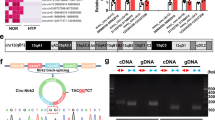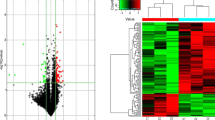Abstract
The present study was performed to screen for potential molecular biomarkers and to assess the underlying mechanisms of chronic thromboembolic pulmonary hypertension (CTEPH) by using sequencing data analysis of microRNAs (miRNAs) and circular RNAs (circRNAs). Total RNA was isolated from peripheral-blood samples from five CTEPH patients and from five normal individuals. Based upon the identification of differentially expressed miRNAs (Affymetrix miRNA chip) and circRNAs (Agilent circRNA chip), target predictions for these differentially expressed miRNAs and functional enrichment analyses of the miRNAs and circRNAs were performed. Subsequently, the miRNA partner predictions of these differentially expressed circRNAs and co-expression analyses of differentially expressed circRNAs and miRNAs were conducted. Based on the results of these analyses, a competing endogenous RNA (ceRNA) network was constructed. Finally, the expression of circRNAs was detected by quantitative real-time PCR (qRT-PCR). Within the miRNA–circRNA regulatory network, hsa_circ_0026480 and hsa_circ_0046159 were predicted to interact with miR-27a-3p and miR-1226-3p, respectively with greater degree. Specially, ATP2A2—that had a ceRNA relationship with hsa_circ_0046159—was predicted as a target of miR-1226-3p. The results of RT-PCR also revealed a significantly increased expression of hsa_circ_0046159 in CTEPH samples than that in normal samples.




Similar content being viewed by others
References
Hoeper MM, Mayer E, Simonneau G, Rubin LJ (2015) Chronic thromboembolic pulmonary hypertension. Neth Heart J Mon J Neth Soc Cardiol Neth Heart Found 23:1
Gall H, Hoeper MM, Richter MJ, Cacheris W, Hinzmann B, Mayer E (2017) An epidemiological analysis of the burden of chronic thromboembolic pulmonary hypertension in the USA, Europe and Japan. Eur Respir Rev 26:160121
Quadery SR, Swift AJ, Billings CG et al (2018) The impact of patient choice on survival in chronic thromboembolic pulmonary hypertension. Eur Respir J 52(3):1800589
Delcroix M, Kerr K, Fedullo P (2016) Chronic thromboembolic pulmonary hypertension. Epidemiology and risk factors. Ann Am Thorac Soc 13(Suppl 3):S201
Ambros V (2004) The functions of animal microRNAs. Nature 431:350
Wang L, Guo L-J, Liu J, Wang W, Yuan JX-J, Zhao L, Wang J, Wang C (2013) MicroRNA expression profile of pulmonary artery smooth muscle cells and the effect of let-7d in chronic thromboembolic pulmonary hypertension. Pulm Circ 3:654–664
Wu HJ, Zhang CY, Zhang S, Chang M, Wang HY (2016) Microarray expression profile of circular RNAs in heart tissue of mice with myocardial infarction-induced heart failure. Cell Physiol Biochem 39:205
Fan X, Weng X, Zhao Y, Chen W, Gan T, Xu D (2017) Circular RNAs in cardiovascular disease: an overview. Biomed Res Int. https://doi.org/10.1155/2017/5135781
Burd CE, Jeck WR, Liu Y, Sanoff HK, Wang Z, Sharpless NE (2010) Expression of linear and novel circular forms of an INK4/ARF -associated non-coding RNA correlates with atherosclerosis risk. PLoS Genet 6:e1001233
Lu D, Xu AD (2016) Mini review: circular RNAs as potential clinical biomarkers for disorders in the central nervous system. Front Genet 7:53
Wu N, Jin L, Cai J (2017) Profiling and bioinformatics analyses reveal differential circular RNA expression in hypertensive patients. Clin Exp Hypertens 39(5):454–459
Hansen TB, Jensen TI, Clausen BH, Bramsen JB, Finsen B, Damgaard CK, Kjems J (2013) Natural RNA circles function as efficient microRNA sponges. Nature 495:384
Cheng X, Joe B (2017) Circular RNAs in rat models of cardiovascular and renal diseases. Physiol Genomics 49:484
Timmons JA, Claes W, Ola L (2005) Considerations when using the significance analysis of microarrays (SAM) algorithm. BMC Bioinform 6:129
Benjamini Y, Hochberg Y (1995) Controlling the false discovery rate: a practical and powerful approach to multiple testing. J R Stat Soc B 57:289–300
Huang DW, Sherman BT, Tan Q et al (2007) The DAVID gene functional classification tool: a novel biological module-centric algorithm to functionally analyze large gene lists. Genome Biol 8:1
John B, Enright AJ, Aravin A, Tuschl T, Sander C, Marks D (2005) Correction: human MicroRNA targets. PLoS Biol 3:e264
Kartha RV, Subbaya S (2014) Competing endogenous RNAs (ceRNAs): new entrants to the intricacies of gene regulation. Front Genet 5:8
Ji Q, Zhang C, Sun X, Li Q (2018) Circular RNAs function as competing endogenous RNAs in multiple types of cancer. Oncol Lett 15:23–30
Bosia C, Pagnani A, Zecchina R (2013) Modelling competing endogenous RNA networks. PLoS ONE 8:e66609
Kohl M, Wiese S, Warscheid B (2011) Cytoscape: software for visualization and analysis of biological networks. Methods Mol Biol 696:291–303
McMurtry MS, Bonnet S, Wu X, Dyck JR, Haromy A, Hashimoto K, Michelakis ED (2004) Dichloroacetate prevents and reverses pulmonary hypertension by inducing pulmonary artery smooth muscle cell apoptosis. Circ Res 95:830–840
Taraseviciene-Stewart L, Scerbavicius R, Choe K-H, Cool C, Wood K, Tuder RM, Burns N, Kasper M, Voelkel NF (2006) Simvastatin causes endothelial cell apoptosis and attenuates severe pulmonary hypertension. Am J Physiol 291:L668–L676
Jin C, Rajabi H, Kufe D (2010) miR-1226 targets expression of the mucin 1 oncoprotein and induces cell death. Int J Oncol 37:61
Cui H, Banerjee S, Xie N, Ge J, Liu RM, Matalon S, Thannickal VJ, Liu G (2016) MicroRNA-27a-3p is a negative regulator of lung fibrosis by targeting myofibroblast differentiation. Am J Respir Cell Mol Biol 54:843–852
Kang B-Y, Park KK, Tan F, Ghosh S, Sutliff RL, Ofori-Acquah SF, Hart CM (2013) Hemin-induced miR-27a reduces PPARγ expression in sickle cell disease with pulmonary hypertension. FASEB J 27:724.722
Aguero J, Ishikawa K, Hadri L et al (2016) Intratracheal gene delivery of SERCA2a ameliorates chronic post-capillary pulmonary hypertension: a large animal model. J Am Coll Cardiol 67:2032–2046
Watanabe S, Ishikawa K, Plataki M et al (2018) Safety and long-term efficacy of AAV1. SERCA2a using nebulizer delivery in a pig model of pulmonary hypertension. Pulm Circ 8:20
Acknowledgements
This study was supported by Beijing Natural Science Foundation (Project Number: 7162069 and 7152062), National Natural Science Foundation of China (Project Number: 81300044, 31670928, 81770253, 81270117, 81570049 and 81200041), Beijing Municipal Administration of Hospitals’ Youth Programme (Project Number: QML20160301), the Open Project of Beijing Key Laboratory of Respiratory and Pulmonary Circulation Disorders (Project Number: 2014HXFB03), the National Key Research and Development Program of China (Project Number: 2016YFC0905600), and the National Major Research Plan Training Program of China (91849111).
Author information
Authors and Affiliations
Corresponding authors
Ethics declarations
Conflict of interest
The authors declare that they have no conflict of interest.
Additional information
Publisher's Note
Springer Nature remains neutral with regard to jurisdictional claims in published maps and institutional affiliations.
Huasong Feng is the first corresponding author, Jiuchang Zhong is the common corresponding author.
Rights and permissions
About this article
Cite this article
Miao, R., Gong, J., Zhang, C. et al. Hsa_circ_0046159 is involved in the development of chronic thromboembolic pulmonary hypertension. J Thromb Thrombolysis 49, 386–394 (2020). https://doi.org/10.1007/s11239-019-01998-4
Published:
Issue Date:
DOI: https://doi.org/10.1007/s11239-019-01998-4




